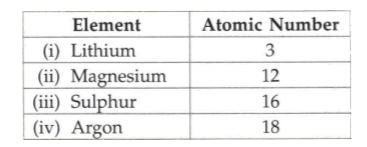(a) How is the valency of an element determined if its electronic configuration is known? Determine the valency of an element of atomic no. 9
(b) Given below are some elements of the Modern Periodic Table. Atomic numbers of the elements are given in the parentheses:
A(4), B(9), C(14), D(19), E(20)
(i) With the help of the electronic configuration, find out which one of the above elements will have one electron in its outermost shell?
(ii) Which rwo elements belong to the same group? Give reasons for your answer.
(iii) Which one of the above elements belonging to the fourth period has bigger atomic radius and why?.
Video Solution
Text Solution
(a) Eleronic configuration is the distribution of electrons in the shells of the atom The number of electrons in the outermost shell will decide the valency of the element. Valency of the element of atomic no. 9 is 1.
Elements (9)⇒2,7
As it gains 1 clectron to fill its shell to attain an octet, its valency is 1.
(b) A(4)⇒2,2 B(9)⇒2,7, C(14)⇒2,8,4 D(19)⇒2,8,8,1 E(20)⇒2,8,8,2
(i) Element 'D' will have one electron in its outermost shell.
(ii) 'A' and 'E' belong to the same group as both of them have two electrons in the outermost shell and their valency is 2. Same group elements have four shells .
(iii) Elements 'D' and 'E' belong to the fourth period as both of them have four shells . As we move from left to right along a period, the atomic radius decrease due to the increase in nuclear charge which tends, to pull the electrons closer to the nucleus and reduces the size of the atom. Thus elements D has bigger atomic radius that elements E.
|
Similar Questions
Knowledge Check
The configuration of the valence orbital of an element with atomic number 22 is
A3d54s1B4s23d2C4s14p1D3d24s14p1
An element with atomic number 5 belongs to III A group of the modern periodic table. Find the number of valence electrons
View SolutionWrite the electronic configuration and valency of the following elements.

View SolutionWrite the electronic configuration of the element with atomic number 102.
View SolutionThe general valence shell electronic configuration of transition elements is
View SolutionWrite the general valence shell electronic configuration of group 14 elements.
View SolutionIn the modern periodic table, the place of the element with atomic number 31 is in:
View SolutionName or state with reference to the elements of the modern periodic table.
The number of electron shells in elements of period 3.
View Solution
